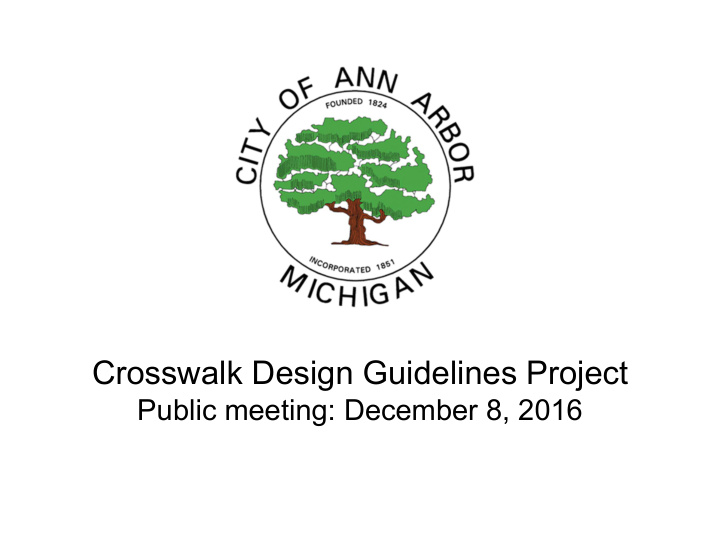



Crosswalk Design Guidelines Project Public meeting: December 8, 2016
Agenda Welcome and introductions (20 min.) Table activity (45 min.) Discussion (45 min.) Next steps (10 min.) Crosswalk Design Guidelines Project 2
Crosswalks are inconsistent Why? 1. Changing regulations 2. Evolution of design practices 3. Individual variance of traffic engineers 4. Resource limitations Crosswalk Design Guidelines Project 3
Desired outcomes of project 1. Consistent, recognizable look/feel for all crosswalks throughout Ann Arbor One size will not fit all 2. Help create clear, shared understanding among all crosswalk users Crosswalk Design Guidelines Project 4
Design guidelines: Source data 1. Prevailing research and best practices 2. National Cooperative Highway Research Program (NCHRP) Report 562 3. North American City Transportation Officials (NACTO) guidelines 4. Examples from peer communities Crosswalk Design Guidelines Project 5
Draft format: Ann Arbor guidelines Treatment categories Road type Standard Standard High Plus Risk Local Collector Arterial ≤ 3 lanes Arterial > 3 lanes Crosswalk Design Guidelines Project 6
Design guidelines in practice Example: State St. between N. & S. University Crosswalk Design Guidelines Project 7
Design guidelines in practice • Example: State St. between N. & S. University – Road Width: 40’ – Roadway Speed: 25 mph – Yielding Compliance: High – Peak Hour: Mid Afternoon – Pedestrian Volume: 250 / hour – Vehicular Volume: 300 / hour – Road Classification: Minor Arterial Crosswalk Design Guidelines Project 8
Design guidelines in practice Crosswalk Design Guidelines Project 9
Design guidelines in practice Crosswalk Design Guidelines Project 10
Design guidelines in practice Example: State St. between N. & S. University Design Options Street Type Standard Standard+ High Risk Location High Visibility Pedestrian Warning Series Rectangular Rapid Markings (W11 ‐ 2) or School Warning Flashing Beacon (RRFB) Series (S1 ‐ 1) R1 ‐ 6a Signs In ‐ Lane or on Pedestrian Hybrid Island Beacon (PHB) Minor & Major Bright Sides Pedestrian Signal Arterials ≤ 3 Stop Here for Ped. (R1 ‐ 5b) Lighting Review Lanes Signs w/ Stop Bar on Multilane Approach Pedestrian Islands or Bump Outs Lighting Review Crosswalk Design Guidelines Project 11
Design guidelines in practice Example: State St. between N. & S. University Crosswalk Design Guidelines Project 12
Table exercise: Introduction Improvements have been requested at three mid-block crossings in a fictitious community Your objective is to select appropriate crossing treatment(s) for each location Data input complete; category identified Total available budget (all 3 locations combined) is $72,000 Crosswalk Design Guidelines Project 13
Table exercise: Assumptions None of the 3 locations have ANY treatment; you are starting from scratch Engineering analysis is complete, accurate Traffic calming (adding stop signs or speed bumps; lowering speed limit) is NOT part of this exercise It is NOT possible to exceed the budget Crosswalk Design Guidelines Project 14
Table exercise: Instructions 1. Conduct a round of introductions 2. Designate a reporter to post your results 3. Review map, data sheets 4. Identify an appropriate treatment(s) for each crosswalk location; place tokens on map 5. Post results on the flip-charts provided Be prepared to discuss: How did you arrive at your decisions? What did you learn in the process? Crosswalk Design Guidelines Project 15
Discussion What do you observe about the decisions that were made in different groups? What could we learn from this exercise? How could/should the results inform the City’s process of refining the draft guidelines? Crosswalk Design Guidelines Project 16
Immediate next steps Continue stakeholder engagement Refine preliminary guidelines Prepare, refine implementation plan Crosswalk Design Guidelines Project 17
Contact information Cynthia Redinger, P.E. City of Ann Arbor Transportation Engineer (734) 794-6410, ext. 43632 CRedinger@a2gov.org Crosswalk Design Guidelines Project 18
Recommend
More recommend